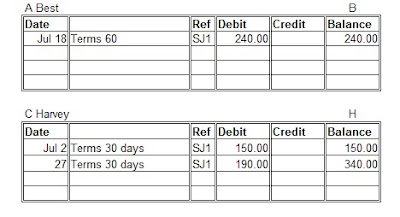Immutable distributed ledgers are the building blocks of blockchain technology.
Blockchain technology revolutionizes the manner organizations conduct business transactions. It works on the peer to peer transaction capabilities without the intervention of any third parties. The core success of blockchain lies in its simplicity and cryptographic security.
In this article we will be looking at the fundamental building blocks of blockchain known as distributed ledgers.
Role of ledgers in business
In today's connected world, businesses span across nations and jurisdictional limits. Business networks come together at the market places where participants, market enablers and stake holders own, control and exercise their rights on objects known as assets.
Assets can be broadly classified into two forms:
- Tangible/physical assets
- Intangible/ virtual assets
 |
| LEDGER |
The ownership and transfer of assets are the transactions which create value in business network. Transactions and contracts are typically recorded in ledgers. Ledgers act as a system of record (SORs) for all business economic activities.
Complications of current business ledgers
There are various problems which exists with the existing business ledgers. They are inefficient, opaque, costly and are prone to misuse. These ledgers are also maintained on a centralized platform which is governed by the trustful third parties like banks. If the centralized ledger system is not secured properly, hackers can easily hack into the system and tamper the valuable ledgers. Lack of transparency in the existing system may lead to disputes.
Since there are multiple third parties (banks) in the current world and they own their own set of centralized ledgers, these ledgers need to be synced when inter-bank transactions occur. These operations are costly and requires multiple validations to ensure the transaction is legitimate.
Distributed ledgers
Blockchain works on the principles of decentralized ledgers. Unlike banks, the ledgers are shared, public and synchronous in everyone who participates in the blockchain network. Instead of relying on the third party, such as financial organizations, members of the blockchain uses a consensus protocol to agree on the contents of the ledger. Digital signatures and cryptographic hashes are incorporated in the ledger to ensure the integrity of financial transactions.
Consensus are nothing but general agreements which a node should comply with, to participate in a blockchain network. Consensus ensures that the shared ledgers are highly synchronized and every node owns the exact copy of the records (in the ledger) without any discrepancies.
Cryptographic hashes like SHA256 algorithms are used to make sure that even a minor change in a transaction record will make the record invalid.
Digital signatures play a vital role in ensuring that the transactions are made by the authorized person who owns the digital asset.
Advantages of decentralized ledgers
The distributed ledgers in the blockchain network prevents any single entity controlling the underlying infrastructure or the system.
- Blockchain reduces the time, risks and costs for processing a transaction.
- Every node in a blockchain network is treated equal and all adhering to the same protocols.
- The transactions results in the blockchain are irreversible or tamper-proof.
I guess by now you have the complete idea on the fundamentals of blockchain (distributed ledger).
Use the comments section to project your views...
TECHOSlovia